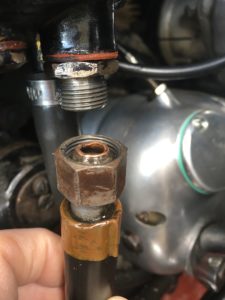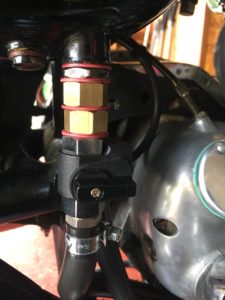‘Wet Sumping’, or having your crankcases full of oil after your vintage motorcycle has been standing for some time is a common problem. Not just for AJS and Matchless owners, but for pretty much all other classic motorcycle owners too. Many suffered from it to some degree, even when the bikes were new. But as they age, the oil pumps wear and oil can find its way passed the plungers and gears in our pumps. If a motorcycle is left long enough, most of the contents of the oil tank can end up in the crankcases or ‘sump’ of the bike. New plungers can be obtained but the last person to refurbish geared pumps has now stopped I believe. Incidentally, the oil gets passed the sides of the gears, not through the teeth.
So what, I hear you say…surely it will pump back into the tank when the engine starts?
Yes, it will, and a little is OK…in fact, if I have drained my bike to work on the engine, I often allow the oil to seep through for a day or so; it allows the pumps and pipes to fill with oil.
If there’s a little too much, your exhaust could be very smoky for a few minutes. If there’s way to much, your bike probably won’t turnover or start…if it does, serious damage could result due to pressure in the crankcases.
You could just remove the sump plug, drain the oil out and put it back in the tank; somewhat messy, but it works.
Some rely on a pressure dependent non-return valve of some kind; if this jams, and they do occasionally, your ‘goose is cooked’ so to speak.
The ideal solution is a manually operated tap, that disables the ignition on the bike until it is very definitely open and able to pass oil at full flow. This tap also needs to fit the old British hose accessories and pipes, whilst ideally, looking the part. I hunted around for some time, finding very ‘Heath Robinson’ home made looking valves, until I came across the perfect tap from Kingpin Components. I procured the version with female connections, with 3/8″ BSP threads and a 1/2″ ID (internal diameter) pipe. I also bought one 1/2″ hosetail and a couple of 3/8″ BSP adapters and fibre washers…I tried rubber O-rings but they just didn’t work reliably.
If you look at the original hosetail and fitting on the bike, it has a tapered olive that actually takes the pipe internal diameter down to 1/4″; that renders the benefits of 1/2″ ID as null and void! The Kingpin Components tap has a ball valve with a true 1/2″ ID that closes a microswitch only when the valve is pretty much fully open.
The outlet pipe was shortened slightly and the two female to male 3/8″ BSP extenders fitted back to back and then into the tap. A 1/2″ hosetail then connected to the original pipe secured with a Jubilee Clip. The feed to the ignition was intercepted by the microswitch so that with the oil turned off, there’s no way to start the engine. Luckily, the 3/8″ BSP threads are pretty much the same as the Whitworth threads on the original fitting.
For me this is an ideal solution.
Kingpin Components have an excellent range of useful products for situations such as this, however ‘they’ are effectively ‘Andy’ and he has lots of other things going on too. They often seem to be out of stock of these taps and Andy will promise delivery then not tell you he has gone to an autojumble or show somewhere. I had to wait quite a few weeks for my tap, but it was well worth the wait.
I asked ACME Stainless to make a bespoke adapter but they said they were too busy. The reason for the adapter by the way, is that the tap assembly needs to be tightened up, and to do that it needs to be lower than the return pipe hosetail which is very close to the feed pipe. A bespoke adapter would be a neater solution.

